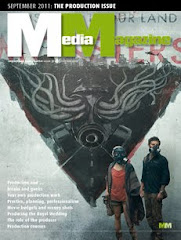Between the Dust and the Devil: An Interview with Richard Stanley
Rose: Your films and documentaries tend to feature strong women – Jill in Hardware, Wendy in Dust Devil, Edelle in The White Darkness. There is also the female cowboy who reveals herself near the close of The Preacher Man promo. Why is this character prevalent in your work?
Stanley: My parents separated when I was four years old and I was raised by my mother and two older sisters. Accordingly women tend to dominate my life and work whereas guys tend to come off as schmucks and ne'er do wells. On a wider level you could say its representative of my undying faith in the restorative power of the Goddess over patriarchal order and the sort of repressive dogma espoused by the Holy Roman Church and the other monotheisms. The Goddess rules.
Rose: Can you tell us a little about your intentions for Jill’s role in Hardware.
Stanley: Jill descends from a long line of embattled heroines, a combination of the 'last girl' of the slasher era and the lead character from a Super 8 movie I started shooting when I was fifteen. I saw her as a sort of 'everywoman' - hence her name which is drawn from Jill's America – the main theme on Morricone's Once Upon A Time In The West album – outsider artist, lover, big sister, 21st century cyber warrior and post technological cave girl all rolled into one. She was initially intended not only as the heroine of Hardware but as a continuing character in her own right.
Colin
Working with low-budgets often forces filmmakers to rule out certain genres and narratives and instead forces them to work with a limited cast, a limited crew and equally limited locations and effects. While these parameters may seem restrictive, they can often work to the benefit of the film itself, making the writer and director focus their narrative and work creatively with what is available in order to achieve a film of quality. With this in mind, choosing to make a zombie film – a genre which is heavy on zombie extras, requiring varied locations which should, preferably, be empty of people, and a whole host of realistic and gory effects – initially seems an ill-fated endeavour. Yet Price’s debut film takes the genre and gives it new life by positioning the film from the titular zombie’s perspective. The premise is this: for an unspecified reason, the undead are returning to life and consuming the flesh of the living. Zombies roam the streets as survivors either barricade themselves within their homes or form large groups to hunt down and slaughter the undead hordes. While fighting a zombie in his home, Colin (Alastair Kirton) is bitten and soon dies. Returning from the dead, he joins the undead masses and stumbles along the streets looking for flesh, encountering other zombies, violent survivors and, eventually, his sister (Daisy Aitkens). As Colin’s undead life unfolds, fragments of his human life are revealed alongside the barbaric acts of the survivors, culminating in a film that subtly meditates on the emotional impact of death and subsequent mourning.



















